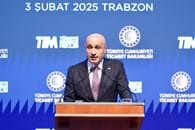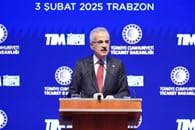Türkiye Achieves Record-Breaking January Exports of $21.2 Billion
In the ranking of the top exporting sectors, the automotive industry maintained its leading position with $3 billion in exports, followed by chemicals at $2.5 billion and ready-to-wear and apparel at $1.4 billion.
Despite the diminishing competitiveness of labor-intensive sectors, Türkiye managed to increase its exports by 2.5% in 2024 and commenced 2025 with a record-breaking performance, achieving the highest January export figures in history at $21.2 billion.
The January export data was announced in Trabzon by Minister of Trade Ömer Bolat and Türkiye Exporters Assembly (TİM) Chairman Mustafa Gültepe.
Speaking at the meeting, which was also attended by Minister of Transport and Infrastructure Abdulkadir Uraloğlu, Mustafa Gültepe reiterated their commitment to the $280 billion export target for 2025. He emphasized that to reach this goal, exports would need to grow by approximately 7% this year and continued:
EXCHANGE RATE IMPACT RESULTED IN A $473 MILLION LOSS IN JANUARY EXPORTS
"According to General Trade System (GTS) records, we achieved exports worth $21.2 billion in January, reflecting a 5.8% increase compared to the same month last year. We anticipate that service exports will amount to approximately $9.4 billion. Examining the sectors specifically, the automotive industry once again led in 2025 with $3 billion in exports, followed by chemicals at $2.5 billion, ready-to-wear at $1.4 billion, steel at $1.25 billion, and electrical-electronics at $1.22 billion. According to TİM data, which is based on companies' registered headquarters, 46 provinces increased their exports last month. The top five exporting provinces were İstanbul, Kocaeli, Bursa, İzmir, and Ankara.
"In January, 1,090 companies engaged in exports for the first time, marking the lowest number in recent years. Nevertheless, these new firms contributed $117 million, which is highly significant. We observe a decline in interest in exports due to weakening competitiveness, which poses a major risk for the future of our exports. Last month, unit export value dropped to $1.47, while exchange rate fluctuations negatively impacted exports by $473 million. Among the top export destinations, Germany retained its leading position, followed by the United States, the United Kingdom, the United Arab Emirates (UAE), and Iraq. We recorded an export increase exceeding 50% in 51 countries and over 10% in 101 countries. Overall, we increased our exports to 128 countries, reaching record-high levels in exports to Slovenia and Jordan."
WE MUST APPROACH HAZELNUTS AS A NATIONAL ISSUE
Mustafa Gültepe highlighted that Trabzon's exports in 2024 surged by 27% compared to the previous year, reaching $1.356 billion. He noted that last year, exports from Trabzon reached 142 countries and regions, adding:
“Trabzon holds significant export potential in hazelnuts, fish, fish oil, defense and aerospace, and automotive sub-industries. Hazelnuts are one of the most crucial sources of income for this region and remain its most significant export commodity. However, we must also acknowledge the growing risks in the hazelnut sector. Our global share in hazelnut exports has declined from 63% to 58% in terms of volume. A decade ago, Chile was barely exporting hazelnuts, but today, it has become a key player. Meanwhile, hazelnut exports from the U.S. and Georgia are rising each year. We must address hazelnut production as a national priority. Above all, we need to enhance per-acre productivity. Additionally, we must find ways to add greater value to hazelnuts. Beyond hazelnuts, Trabzon should strengthen its product diversity through industrial manufacturing.”
WE WILL CONDUCT AN INTENSIVE TRADE MISSION PROGRAM IN 2025
Gültepe also commented on current global developments and concluded his speech as follows:
“We have embarked on 2025 with an export target of $280 billion. To reach this goal, we must increase our exports by 7%. With our existing potential, we can achieve even greater success. However, we must, at the very least, correct the adverse conditions that undermined our competitiveness last year by ensuring a balance between inflation and exchange rates. Of course, we cannot ignore global geopolitical developments. The United States is our second-largest export market, and Donald Trump's potential second presidential term will undoubtedly impact our trade. Likewise, we will closely monitor developments in Syria. On the other hand, we will execute an intensive trade mission program in collaboration with our exporters' associations this year. Indeed, we will mobilize all our resources to achieve the $280 billion export target.”




